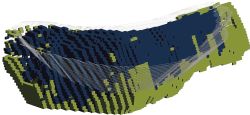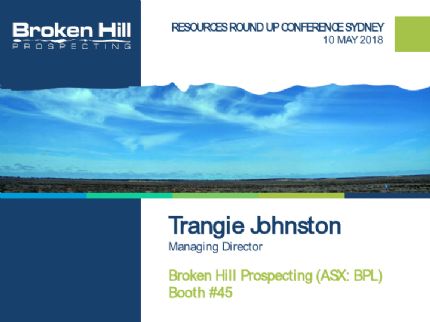 Scoping Study Update - Strong Potential
Scoping Study Update - Strong Potential
Sydney, July 12, 2017 AEST (ABN Newswire) - Cobalt Blue Holdings Limited ( ASX:COB) is pleased to advise that it has completed a Scoping Study ("Study") based on the Inferred and Indicated Mineral Resource at its Thackaringa Cobalt Project ("the Project"), located approximately 23 km south west of Broken Hill, NSW. The Study referred to the Pyrite Hill, Big Hill and Railway deposits. The Study was a key milestone of our joint venture with Broken Hill Prospecting Limited (
ASX:COB) is pleased to advise that it has completed a Scoping Study ("Study") based on the Inferred and Indicated Mineral Resource at its Thackaringa Cobalt Project ("the Project"), located approximately 23 km south west of Broken Hill, NSW. The Study referred to the Pyrite Hill, Big Hill and Railway deposits. The Study was a key milestone of our joint venture with Broken Hill Prospecting Limited ( ASX:BPL).
ASX:BPL).
- Scoping Study completed. Results indicate a technically and economically justifiable project warranting progression to Pre-Feasibility Study. Results supportive of Cobalt Blue's aspirational target of becoming "a long-life top 10 cobalt miner".
- Thackaringa retains strong exploration upside with resource size supporting long-life operations. Broken Hill (23km away) provides clear infrastructure advantages with people, power, water, road and rail availability.
- A range of cobalt processing routes were examined during testwork, with roasting and pyrolysis in particular displaying attractive technical and cost efficiencies. Both processes produced high levels of cobalt recovery and will be evaluated in more detail in future studies.
Cautionary Statement
The Scoping Study is a preliminary technical and economic study of the potential viability of the Thackaringa Project required to reach a decision to process with more definitive studies. It is based on low level technical and economic assessments that are not sufficient to support the estimation of ore reserves. Further exploration and evaluation work and appropriate studies are required before Cobalt Blue will be in a position to estimate any ore reserves or to provide any assurance of an economic development case.
The Scoping Study was based on material assumptions including assumptions about the availability of funding. While Cobalt Blue considers all of the material assumptions to be based on reasonable grounds, there is no certainty that they will prove to be correct or that the range of outcomes indicated by the Scoping Study will be achieved.
To achieve the range of proposed feasibility studies and potential mine development outcomes indicated in the Scoping Study, additional funding will likely be required.
Investors should note that there is no certainty that Cobalt Blue will be able to raise funding when needed. It is also possible that such funding may only be available on terms that may be dilutive to or otherwise affect the value of Cobalt Blue's existing shares. It is also possible that Cobalt Blue could pursue other 'value realisation' strategies such as a sale, partial sale or joint venture of the project. If it does, this could materially reduce Cobalt Blue's proportionate ownership of the project.
Given the uncertainties involved, investors should not make any investment decisions based solely on the results of the Scoping Study.
In accordance with ASX Interim Guidance: Reporting Scoping Studies, the ASX Listing Rules and ASIC Information Sheet 214, Cobalt Blue understands that the portion of inferred mineral resource currently defined is a determining factor in project viability and features as a significant proportion early in the mine plan, preventing reporting of a production target or forecast financial information based on a production target.
The Scoping Study results were positive and justify progression to a Pre-Feasibility Study. BPL Chairman, Creagh O'Connor commented:
"We have long believed that the cobalt resource at Thackaringa has considerable potential, and these scoping study results provide major impetus towards proving that to be true. We are committed to pursuing the plans for development of the project, and working with Cobalt Blue to achieve that end."
Shareholders can expect a further update on strategy from the CEO in the near future.
Geology and Resources
Stage One activities have been focused on the three known deposits. Resource definition work will continue during Stage Two of the JV, targeting conversion of exploration targets to Mineral Resources. A key requirement of Stage Two is to define a sufficient quantity of Indicated Resource to support the optimal mining throughput defined in the Scoping Study.
Cobalt Blue has delivered 7,956.9m of Diamond (22 holes) and Reverse Circulation (38 holes) drilling over 2016 and YTD 2017. The program was the basis for a substantial resource upgrade (5 June 2017) and the preparation of a comprehensive Scoping Study. The resource estimate was completed using a 500ppm cobalt cut off and is summarised in Table One in the link below. A 54.9Mt Mineral Resource (consisting of 48.4Mt Inferred Resource and 6.5Mt Indicated Resource), reported in compliance with JORC (2012), was estimated with an average grade of 910ppm, 10.19% iron and 9.56% sulphur. Compared to the previous mineral resource, the new resource contains 66% more tonnes and 81% more cobalt.
The updated Total Mineral Resource estimate at Thackaringa is apportioned to the three main deposits as follows (minor rounding errors may have occurred in the compilation of this table) (see the link below).
Additional resource potential has been defined through the identification of the following exploration targets (see the link below).
The potential quantity and grade of these targets is conceptual in nature. There has been insufficient exploration to define a Mineral Resource and it is uncertain if further exploration will result in determination of a Mineral Resource.
These exploration targets were constrained at depth to approximately 250-300m below surface where data density is limited. It must be considered there is currently no known geological constraint that would preclude potential extensions below the existing interpretation however the viability of such mineralisation as an open pit target is unlikely (Figures One and Two in the link below show oblique views of the Railway and Pyrite Hill deposits).
Mining Update
Pit optimisations were performed for Big Hill, Pyrite Hill and Railway deposits spanning a range of mine economics from smaller scale to a globally significant cobalt operation. Existing mineral resources are all open pit, with near surface resources supporting low strip ratio mining operations. The resource size supports long-life operations with the mining study confirming that low mining costs are possible due to low strip ratios present.
Processing Update
As a result of the Scoping Study, COB has identified a number of low operating cost options that simultaneously have the potential to generate revenue for cobalt, sulphur and iron products. These options will be investigated in larger scale bulk testing, as the project progresses into FY18.
In the Scoping Study, the approach has been to develop a new dataset from first principles. Subsequently, a more robust engineering, design and financial study was completed, relative to previously published studies on the Thackaringa deposits.
Ore processing was assessed into two separate components, namely:
1. Concentration of ore; followed by
2. Concentrate processing.
Concentration
Flotation of pyrite was straightforward, with only a bulk sulphide collector (Xanthate) required and a coarse grind size of 212microns. Flotation produced strong typical recoveries (91.5%) of cobalt. Gravity separation was also examined, using a much coarser crush size of 1180 microns, also displaying strong recoveries of (91.7%) cobalt.
An engineering study compared concentration of the cobalt from the ore using flotation and gravity separation techniques. From a capital and operating cost perspective, a combined gravity-flotation circuit was identified as the preferred option for further evaluation in future studies.
Additionally, the use of high speed X-ray sorting equipment was trialled to remove waste product prior to milling - this process will be subject to further bulk testing to assess the liberation of the minerals hosting cobalt from the crushed ore.
Concentrate Processing
The criteria for development of a viable processing flowsheet is listed in order of importance:
1. Unlocking cobalt from the pyrite lattice, so that the cobalt can be separated and recovered as a saleable product.
2. Treating the pyritic sulphur to convert it into saleable forms, or making it amenable for low-cost disposal by minimising the opportunity for generation of acid in long-term storage dumps.
3. Recovering iron oxide from the process for sale.
Concentrate processing trials examined five options, namely:
a) Concentrate Pyrolysis (Decomposition) + Low Pressure Oxidation Leaching of the Calcine.
b) Concentrate Roasting + Atmospheric Leaching of the Calcine.
c) Conventional High-temperature Pressure Oxidation Leaching (POX) of the Concentrate.
d) Concentrate Roasting + Acid Production + Calcine Leaching.
e) Atmospheric Leaching of the Concentrate.
Options A and C achieved the highest cobalt extractions into the leach liquors of >95%. An engineering study compared the capital and operating costs of each of the options, and identified that Option A had the lowest costs. Further, Option A could potentially generate the highest revenues, as sulphur and iron could also be monetised along with the cobalt in this scenario.
The company is taking steps to protect the intellectual property developed in the Scoping Study. This is specifically in relation to Option A.
The process options evaluated in the Scoping Study are compared in the table below (see the link below).
The pyrolysis process, potentially allowing monetisation of cobalt, sulphur and iron, represents the most desirable metallurgical process going into the Preliminary Feasibility Study, being undertaken as part of Stage Two of the Project. Notwithstanding early positive indications from the Scoping Study, all processes will be further examined in more detail before a preferred option is selected.
Next Steps
The Scoping Study has confirmed a potentially viable project. These results provide justification for Cobalt Blue to proceed further along the pathway towards development. In parallel with further development of the Thackaringa resource, the next priority is to prove, on a more rigorous and larger scale, the technical and commercial viability of key processing routes in order for the Company to select the preferred process for commercialisation of the deposits.
Cobalt Blue is focussed on bringing the Project into development with an accelerated feasibility program aiming to deliver a Bankable Feasibility Study, along with requisite approvals, by mid 2019. The Study represents a milestone in our aim to develop the Thackaringa Project, as shown in Figure Four below (see the link below).
To view tables and figures, please visit:
http://abnnewswire.net/lnk/1ET8D16D
About Cobalt Blue Holdings Limited
 Cobalt Blue Holdings Ltd (ASX:COB) (FRA:COH) (OTCMKTS:CBBHF) has a strategic approach that positions us to be among the first wave of new entrants into the allied battery materials supply chain. We are committed to playing a leading role in securing a stable and sustainable future for critical minerals.
Cobalt Blue Holdings Ltd (ASX:COB) (FRA:COH) (OTCMKTS:CBBHF) has a strategic approach that positions us to be among the first wave of new entrants into the allied battery materials supply chain. We are committed to playing a leading role in securing a stable and sustainable future for critical minerals.



![abnnewswire.com]()
Related Companies
Social Media
Share this Article

 ASX:COB) is pleased to advise that it has completed a Scoping Study ("Study") based on the Inferred and Indicated Mineral Resource at its Thackaringa Cobalt Project ("the Project"), located approximately 23 km south west of Broken Hill, NSW. The Study referred to the Pyrite Hill, Big Hill and Railway deposits. The Study was a key milestone of our joint venture with Broken Hill Prospecting Limited (
ASX:COB) is pleased to advise that it has completed a Scoping Study ("Study") based on the Inferred and Indicated Mineral Resource at its Thackaringa Cobalt Project ("the Project"), located approximately 23 km south west of Broken Hill, NSW. The Study referred to the Pyrite Hill, Big Hill and Railway deposits. The Study was a key milestone of our joint venture with Broken Hill Prospecting Limited ( ASX:BPL).
ASX:BPL).  Cobalt Blue Holdings Ltd (ASX:COB) (FRA:COH) (OTCMKTS:CBBHF) has a strategic approach that positions us to be among the first wave of new entrants into the allied battery materials supply chain. We are committed to playing a leading role in securing a stable and sustainable future for critical minerals.
Cobalt Blue Holdings Ltd (ASX:COB) (FRA:COH) (OTCMKTS:CBBHF) has a strategic approach that positions us to be among the first wave of new entrants into the allied battery materials supply chain. We are committed to playing a leading role in securing a stable and sustainable future for critical minerals.















